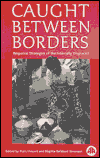| |
BOOK REVIEW
Struggles of the
invisible refugees
Caught Between Borders: Response Strategies of the
Internally Displaced
Edited by M Vincent & B R Sorensen
Reviewed by Sreeram Chaulia
 Among
the new challenges confronting the humanitarian and human rights
comity, the most burning and intractable is that of internally
displaced persons (IDPs), people who have been forced to flee
their homes as a result of war and generalized violence, but who
do not cross an international border. There are an estimated 25
to 30 million IDPs in the world today, leapfrogging from 7
million in 1990, and begging an urgent remedy from the United
Nations system. No single international organization or legal
instrument has the resources or mandate to cater to the
immediate and long-term needs of IDPs. National governments, who
normally have the primary responsibility of ensuring the rights
and wellbeing of their citizens, are either insensitive to or
directly responsible for IDP situations. Forlorn and woebegone,
unlike their relatively better cared for cousins, refugees, IDPs
are forced to devise innovative and courageous responses to
adversity with scanty external inputs. Among
the new challenges confronting the humanitarian and human rights
comity, the most burning and intractable is that of internally
displaced persons (IDPs), people who have been forced to flee
their homes as a result of war and generalized violence, but who
do not cross an international border. There are an estimated 25
to 30 million IDPs in the world today, leapfrogging from 7
million in 1990, and begging an urgent remedy from the United
Nations system. No single international organization or legal
instrument has the resources or mandate to cater to the
immediate and long-term needs of IDPs. National governments, who
normally have the primary responsibility of ensuring the rights
and wellbeing of their citizens, are either insensitive to or
directly responsible for IDP situations. Forlorn and woebegone,
unlike their relatively better cared for cousins, refugees, IDPs
are forced to devise innovative and courageous responses to
adversity with scanty external inputs.
This collection of 10 case studies from Africa, Asia, Latin
America and Europe documents sui generis coping
mechanisms that IDPs in various trouble zones of the world have
developed to barely survive and live another day. The intention
of the editors in compiling such an anthology is to "look more
closely at local capacity" and "provide a counter-discourse to
the traditional hegemonic humanitarian labels of 'vulnerable
groups', 'beneficiaries' and recipients'." (p 6) Perceiving IDPs
as passive recipients of aid and denying their ability and
agency to determine their own destinies are serious flaws
residing in the psychology of humanitarian actors who lack the
"ability to listen". Vincent and Sorensen hope that Caught
Between Borders is "the first step towards abandoning the
humanitarians' self-image as benefactors". (p 281).
Angola
Nina Birkeland and Alberta Gomes narrate the horrors of being
Deslocados (Portuguese for 'out of place') in Africa's
longest and most internecine civil war. As many as 3.8 million
Angolans have fled homes and native places to escape the ravages
and atrocities of 37 years of Government-UNITA fighting over
power and mineral wealth. In Huambo province, new Deslocados
do not have access to fields, unlike the 'established' IDPs from
previous decades, even though both groups can be said to be
leading a hand-to-mouth existence. Resettlement centers, which
are located closer to home villages of the IDPs to enable them
to travel and farm on their own lands, have living conditions
"unfit for animals". (p 31)
Lack of security compounds destitution, what with UNITA soldiers
seizing whole villages and using machetes to murder civilians,
thereby saving bullets for fighting the Angolan army. IDPs have
formed 'civil defense groups' with light arms to try to ward off
soldiers, but these squads are regularly ambushed and
slaughtered. The preponderance of landmines in the countryside
has led to as many as 17 people from the Caliamama camp being
killed in one month of the year 2000. Exploding mines play
spoilsport with subsistence activities like firewood collection
and trading in the informal sector. Though external agencies try
to provide some accessible IDPs with seeds and tools, "lack of
safe arable land means people are likely to end up eating the
seeds they are supposed to plant if they have no other source of
food". (p 42) Government favoritism toward investing business
firms and powerful NGOs has also led to land farmed by IDP
families being snatched away and given to oil companies and
so-called "environmentalists". The low cost self-help strategies
of Deslocados have little potential to generate decent
incomes in the face of such institutional obstacles.
Burundi
G Boutin and S Nkurunziza profile IDPs in one of the world's
poorest countries, Burundi. Political violence by fanning of
ethnic hatred has forced hundreds of thousands of Burundians
into successive waves of displacement since the 1960s. For the
subsistence farmers of Burundi, "displacement can mean
starvation, since they generally have few sources of cash
income" and no savings. (p 51) The government's controversial
policy of forced "regroupment" of civilians in Bujumbura Rurale
province has accentuated loss of livelihoods. Most of the
regroupement camps have "no access to water or sanitation, and
most inhabitants suffered from hunger and disease". (p 57) IDPs
feel that their dignity and pride have been seriously undermined
by confinement in these camps. In Rutana province, when military
posts in charge of protecting the camps leave, adults keep night
vigils to protect or warn against rebel or government attacks.
As a result, "men and women became weak from lack of rest and so
had difficulty tending their plots during the day". (p 64)
So meager and unsuitable is humanitarian assistance that many
IDP families sell goods received from NGOs and the UN to
soldiers and local government officials. Though all IDPs desire
education for the young, girls and orphaned children are kept
away from local schools to care for newborns or earn
supplementary income. In some heart-rending cases, impoverished
parents "brought their own children to an orphanage, claiming
that the children's parents were dead". (p 72) Boutin and
Nkurunziza find interestingly and sadly that there is a
"learning curve" concerning displacement among Burundians, with
the more "experienced" IDPs who have fled repeatedly in a better
position to identify risks from rumors and planning ahead.
Sudan
K Jacobsen, S Lautze and A M Osman research the festering sore
of Sudan, which has the greatest number of IDPs in the world,
both absolutely and as a percentage of total population. Since
1983, the Islamic dictatorship based in Khartoum bombed and
displaced civilians in the south as part and parcel of its war
against Christian and animist rebels and for exploiting oil
fields. Those IDPs who have migrated to Khartoum are under
constant government harassment and intimidation. Southerners in
Khartoum face a "particularly virulent form of oppression based
on ethnicity, religion, socio-economic class, geographic origin
and political affiliation". (p 82) Since the late 1980s, more
than 1 million IDPs have lost their homes - often more than once
- to the Housing Ministry's bulldozers for "slum clearance" and
"city beautification" purposes.
After 22 protestors of demolitions were shot in 1992, IDPs have
a new passive resistance strategy of salvaging roofing and other
valuable materials before the bulldozers arrive. Revolving
community funds (sanduk), financed by regular small
contributions out of savings, have been established by IDPs to
be disbursed to families which are unable to afford school fees,
bribes, medical and travel expenses. The level of penury is so
abject in some cases that "displaced women are deliberately
becoming pregnant to qualify for food rations allocated for
pregnant and lactating women". (p 91). IDP women are also faced
with the constant fear of arrest and imprisonment under the
strict Kasha laws that have been imposed in the name of Sharia.
A Kasha Sanduk fund for coping with arrests and related fines
and confiscations is also in operation. Unaccompanied street
children in Khartoum sleep in defunct drainage pipes to avoid
conscription into the army and indulge in petty theft and
begging by day to eke out a square meal.
Uganda
A Olaa takes up the case of the lesser known Acholi IDPs of
northern Uganda, who have been displaced by intense fighting
between the Christian fundamentalist Lord's Resistance Army, the
Holy Spirit Movement and government forces. Since the mid '90s,
these rebel armies looted and burned homes, abducted and
tortured inhabitants, laid landmines along village paths and
ambushed civilian commercial traffic. Children are specifically
targeted for forcible recruitment and kidnappings. Forced to
relocate to Kitgum town and adjoining villages, the Acholi have
fallen back on traditional beliefs, customs and clan networks to
tide over difficulties. The power of spirits and ancestral
intervention, which were gradually eroding in the
pre-displacement era, have made a comeback and help rationalize
present calamities in the minds of the IDPs. A traditional
justice system, based on reconciliation rather than punishment,
is used in the camps to settle disputes, helping to bind the
community together.
If reversion to tradition is one interesting coping mechanism,
some traditional practices are also being replaced. Women make
small-scale savings and invest them in a revolving fund,
kalulu, for starting tiny handicrafts or alcohol brewing
businesses. Men, who used to be breadwinners in the past due to
farming knowledge, now "felt that their authority over the
family was undermined by the women's new economic clout",
causing domestic discord (p 108). Child prostitution and
begging, unknown phenomena in the Acholi value system, are other
harmful practices that have cropped up among IDP families
desperate for additional income.
Afghanistan
G Farr's essay on Afghan IDPs reveals the classic situation of
IDPs sandwiched between borders and unable to cross over and
become refugees. Twenty five years of crisis of governance and
order, beginning in 1978, have left more than 1 million Afghans
internally displaced. Location of fighting and the attitudes of
surrounding countries have prevented most Afghans from leaving
the country entirely. Until late 2001, the main escape routes to
the south and east were under Taliban control and the borders
into Pakistan, Uzbekistan and Tajikistan were closed. Caught
between a rock and a hard place, Afghans have fled wherever
there is hope of minimum safety.
In the Panjshir valley, an estimated 50 to 70 percent of the
displaced had no food, as of March 2000. According to UNICEF,
268,000 Afghan displaced children die each year from easily
treatable illnesses. Subsistence farmers try retaining major
mobile assets like cattle and roofing when they flee and very
often IDPs return to their lands to cultivate clandestinely,
traveling at nights by circuitous routes. These daring attempts
are not enough to feed and clothe all IDPs and so begging and
human trafficking are common. A generation of Afghan IDP youth
has grown up without even a traditional education. Taliban's
totalitarian Sharia rules exacerbated economic difficulties of
IDPs, especially women who had no male relatives or employment
avenues. The craters of war and displacement will take decades
to heal, assuming that the present tenuous peace will hold.
Burma (Myanmar)
C Cusano's brilliant chapter on 200,000 Karen IDPs in Burma's
southeast shows that various displacement experiences - hiding
in the jungle, fleeing to a refugee camp in Thailand, migrating
to the city or finding a job abroad - "are not always distinct
routes, but steps along a single path", ie, milestones on a
journey of endless displacement. (p 140) Karens flee not only
the brutality of the Burmese military junta but also draconian
demands of the rebel Karen National Union, which requires
households under its administration to contribute one member to
"the revolution". The Burmese army, on the other hand, marks off
an area populated by Karen civilians and sends orders to "clear
it" in 24 or 48 hours.
Since forests are safest, most IDPs hide there, but "life in the
jungle is harsh, and becomes even harsher the longer people
stay". (p 150) Despair and displacement in Karen mythology and
folklore are used to explain present-day woes and find solace in
the troubles previous generations had with the dominant Burman
race. Karens "describe themselves as disenfranchised people ...
transformed from indigenous people to strangers on their own
land within 50 years". (p 153) For physical survival, IDPs stash
rice in well-concealed locations in the jungle, but the risks of
termites and wild animals discovering it are phenomenal. Cusano
has observed some IDPs dividing their rice and belongings into
smaller stashes to spread the risk. If discovered, executions,
beatings and rape are other dangers of hiding grain from
soldiers.
Covert barter trade in commodities and food also occurs in
Tenasserim province between jungle IDPs and those in nearby
"relocation centres". Some Karens join armed groups with no
other end in sight. To escape military infliction, male Karen
villagers are becoming Buddhist monks, who are spared by
warriors. Despite hazards of travel, many IDP families send
their children across the border to Thai refugee camp schools.
But for the tightening of border patrols and asylum laws in
Thailand, the IDPs would wish to become refugees rather than
suffer a listless fate inside Burma.
Sri Lanka
Co-editor Sorensen's account of the 100,000 Muslim Tamil IDPs in
Sri Lanka brings out a case of internal discrimination among the
minority Tamils on the basis of religion. LTTE rebels believe
that Muslim Tamils act as informers for the government and began
ordering out Muslims from the Puttalam-Mannar area from 1990
onwards, with no more than one polythene bag containing personal
belongings. In ad hoc village settlements and welfare centers,
IDPs have re-established zakat funds, the traditional
Muslim system of charity, to assist those in need.
Besides working as field laborers, some IDP men invest in
commercial onion production, but with few successes. "No matter
how hard they work, they cannot save enough to be able to invest
in their own equipment and build up their own businesses." (p
187) As women's economic contributions to the household
increased through brisk sale of palmyra leaf baskets, the sexual
distribution of labor has undergone changes and abrasions. The
unique institution of a Mosque Trustee Board (MTB) has emerged,
negotiating with LTTE and government troops, overseeing welfare
funds that support children's education and settling internal
disputes. The MTB adopts subtle ploys of "avoidance, compliance
and silence" when talking to and dealing with armed groups. But
no amount of community bonding is able to prevent premature
marriages, child labor and other egregious ways which are
outcomes of deteriorating social services in a country which was
once a model of prosperity for South Asia.
Colombia
E H Delgado and T Laegreid unearth the endangered existence of 2
million Colombian IDPs, who have formed "occupational layers" of
sorts in the 50-year civil war. The authors found highly
developed warning systems in areas that were traditionally well
organized. In Bucaramanga, "people used cattle horns to make
far-reaching sounds that would warn others of the proximity of
armed forces". (p 208) The most wanted persons of the
paramilitary or FARC rebels stay in different houses after 5 pm
to minimise chances of being taken away or killed altogether.
"Colonization" of forest areas for virgin land farming, while
keeping IDPs from starving, is endangering the environment.
Younger IDPs veer towards joining the warring factions since
they offer good salaries, clothing, food and lodging in return
for wielding guns. Families of youths who have joined militias
use silence as the most effective protection strategy. "Not to
disclose, or lie about, who you are and where you came from can
increase the chances of survival." (p 212) "Peace Communities"
which declare certain areas as possessing civilian autonomy from
armed raids have been experimented with and yielded positive
benefits for freedom of movement and temporary rebuilding of
homes. Ollas Communiatarias, or soup kitchens, have aided
maintenance of minimal nutrition standards. However, "rental
nomads", street panhandling and prostitution are inevitable
fates of IDPs in a country with no infrastructure for
development. But for occasional bright spots like a displaced
teacher in Villavicencio starting a school after his children
could not be admitted to a local school, Colombian IDPs have a
baleful future to look forward to.
Georgia
J Kharashvili's portrait of the 280,000 IDPs of Georgian origin
who were expelled from Abkhazia after the break-up of the USSR
is less tragic than the African, Asian or Latin American cases,
as the levels of privation and suffering are not as extreme.
Footwear has been in short supply after the 1992 attack of
Abkhaz rebels and the mass exodus into interior regions of
Georgia. A displaced woman in Racha-Lechkhumi is teaching IDPs
in the communal center to knit thick socks for the winter and
the model has gradually been exported to other IDP camps. Lack
of space and dwindling electricity and household facilities are
causing intense distress to a community that was once fairly
well off.
The decision of the Georgian central government to sustain the
Georgian provincial government of Abkhazia "in exil" has helped
some IDPs to continue to work in bureaucracy and professional
posts. In Kutaisi, IDPs have started, with government
assistance, a big tea and stationery firm. For the less
fortunate, selling cigarettes, nuts and other popular items in
Tbilisi and across the Russian border is a staple form of
employment. In case there is a severe bread shortage in some
years, some IDPs sell part of their daily rations to local
consumers. Local and international NGOs have set up
"psycho-social" counselling and training centers to help
affected IDPs overcome trauma and find jobs.
Yugoslavia
V Ilic's study of the 220,000 Serbian IDPs from Kosovo
illustrates advanced preparation for flight as a special
strategy. Most ethnic Serbs prepared for decades for the 1999
eventuality by saving money and weaving a network of connections
in central Serbia to receive and host them. The Roma gypsies of
Kosovo, who fled with the Serbs without prior planning, are
living in cramped camps ("20 people into a 4 square metre room")
of Kragujevac, Deponija etc. Both Serbs and Roma from Kosovo
face the hostility of Serbs in Yugoslavia as they are considered
guilty of provoking NATO's bombing by staunchly supporting
Slobodan Milosevic.
Left to themselves with minor NGO and international aid, the
IDPs in Belgrade earn their living almost entirely through
illegal activities or by manual labor as unregistered workers.
The former sub-elite and elite among Kosovo's Serb politicians
do not assist ordinary IDPs at all. Illegal food trade with
Montenegro in citrus fruits and meats exists, but displaced
persons are brutally exploited in both the legal and illegal
sectors of the Serbian economy. Kosovo Serbs "must endure
insults, physical violence, stoning and attempted murder" every
time they step out of their ghettos, leading most respondents in
a recent opinion poll to say they would gladly return home to
Kosovo if accorded military protection against the KLA. (p 264)
Conclusion
"Capacity building" is the new buzz phrase in the humanitarian
world, but it has not moved beyond the point of rhetoric and lip
service. A methodically researched volume commissioned by the
Norwegian Refugee Council, Caught Between Borders
pleads the case for "walking the talk" and bolstering the
capabilities, skills and strategies that IDPs possess
intrinsically or have evolved in the face of extreme hardships.
The lesson for UN and NGO practitioners is not just to read this
book and adopt attitude changes about the human capital inherent
in IDPs, but also to plan external interventions and solutions
that are complementary to IDP ingenuity and resourcefulness
instead of imposing them from above.
One would have wished for chapters on the 500,000 Kashmiri Hindu
IDPs in India and the 2 million IDPs in the Congo, but there is
always scope for a sequel to cover the invisible refugees whose
stories could not be fitted into this volume.
Caught Between Borders: Response Strategies of the
Internally Displaced, edited by M Vincent & B R
Sorensen, (Pluto Press, 2001), ISBN 0-7453-1818-5, price
US$23.95, 317 Pages.
(©2002 Asia Times Online Co, Ltd. All rights reserved. Please
contact
[email protected] for
information on our sales and syndication policies.)
|
| |
|
|
 |
|




 Among
the new challenges confronting the humanitarian and human rights
comity, the most burning and intractable is that of internally
displaced persons (IDPs), people who have been forced to flee
their homes as a result of war and generalized violence, but who
do not cross an international border. There are an estimated 25
to 30 million IDPs in the world today, leapfrogging from 7
million in 1990, and begging an urgent remedy from the United
Nations system. No single international organization or legal
instrument has the resources or mandate to cater to the
immediate and long-term needs of IDPs. National governments, who
normally have the primary responsibility of ensuring the rights
and wellbeing of their citizens, are either insensitive to or
directly responsible for IDP situations. Forlorn and woebegone,
unlike their relatively better cared for cousins, refugees, IDPs
are forced to devise innovative and courageous responses to
adversity with scanty external inputs.
Among
the new challenges confronting the humanitarian and human rights
comity, the most burning and intractable is that of internally
displaced persons (IDPs), people who have been forced to flee
their homes as a result of war and generalized violence, but who
do not cross an international border. There are an estimated 25
to 30 million IDPs in the world today, leapfrogging from 7
million in 1990, and begging an urgent remedy from the United
Nations system. No single international organization or legal
instrument has the resources or mandate to cater to the
immediate and long-term needs of IDPs. National governments, who
normally have the primary responsibility of ensuring the rights
and wellbeing of their citizens, are either insensitive to or
directly responsible for IDP situations. Forlorn and woebegone,
unlike their relatively better cared for cousins, refugees, IDPs
are forced to devise innovative and courageous responses to
adversity with scanty external inputs. 








